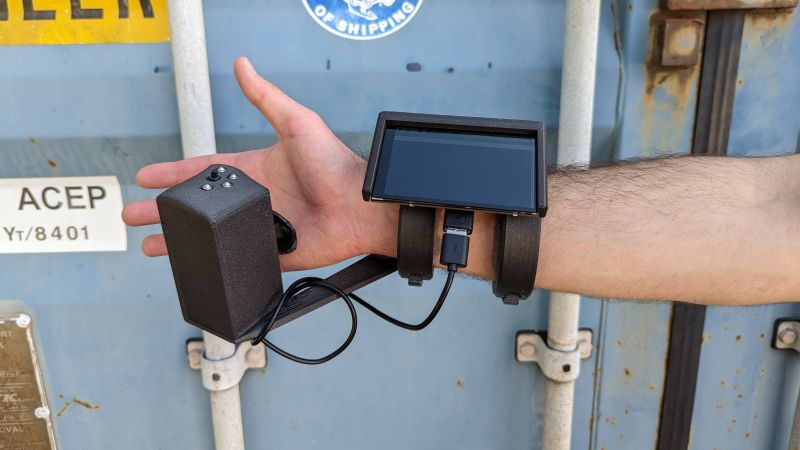Those of us who are unreformed hunt-and-peck typists are often baffled by the keyboard skills of those with more formal training. Home row? Specific fingers for specific keys? The mind boggles. And chorded keyboards? That’s straight-up witchcraft!
But, there are times when only a chorded keyboard will do, such as when you want to build a wrist-wearable cyberdeck like this one. It’s called the ComputeDeck-B3, and it comes to us from [Nate Damen], better known as someone who goes around with a TV on their head, which sort of fits with the total device immersion this cyberdeck enables.
The deck is designed to fit on the forearm in the position of function — basically, the posture your arm, wrist, and hand take on naturally when everything is relaxed. There’s a small display mounted at a good angle for viewing, but the star of the show is the keyboard. The fingers slip inside a slot to find three mechanical key switches positioned for each finger. It looks like the idea is to use the finger pad, fingertip, and fingernail to press each key, and then to press different combinations of keys to make specific characters. The thumb isn’t left out of the action; there’s a five-position “hat switch” located right where the thumb naturally falls, to add to the input possibilities. The short video below gives a tour and some background on design goals, and why this isn’t really a PipBoy.
For as much as chording isn’t our thing, we can see how this could work for input on the fly. And we have to compliment [Nate] on paying attention to ergonomics here, even though extending the fingers to press the nail buttons seems like a somewhat unnatural movement. We’d love a follow-up on this after he’s had some time to put it through its paces.

















You can’t have a wearable cyberdeck. Those concepts are mutually exclusive.
A cyberdeck is a portable computer, with 2 or more pieces, that must be set up at the location of use.
Laptops are not cyberdecks because they only have 1 piece.
Wearable computers can’t be cyberdecks because they are usable without having to set them up on location.
“A cyberdeck is a portable computer, with 2 or more pieces, that must be set up at the location of use.”
I remember when DIY portable desktops were popular, only they were called “LAN party boxes” back then.
The cyberdeck was also invented by a man who had never seen a computer, much less a laptop in his life, so getting technical on the definition seems a little petty
He was familiar with typewriters.
Where does your definition comes from? When I google “cyberdeck definition”, I find this: https://en.m.wiktionary.org/wiki/cyberdeck
Which doesn’t have to do anything with location or number of parts, but rather if it’s connected to the internet or not.
I mean if you want to be technical cyberdeck actually refers to a fictional piece of gear from William Gibson’s neuromancer that jacks directly into your brain and visually represents clusters of data in 3d space. If you go by that definition and temper it down to what’s possible today VR kits and anything with an hmd are the true cyberdeck.
That being said the definition I’ve always heard is a home built portable computer that take a non-standard or non-mainstream form factor. This meets both of those criteria.
If the essential element is a chord keyboard than a Decatxt 10 key one hand keyboard is a good choice. Should be coming out with version 3 with USB and Bluetooth in a few months. Unfortunately nothing available now but should be a few USB only around soon on Amazon. Has anyone tried using Twiddler, Tap or a BAT one hand keyboard?
Hey Wayne totally agree if it’s just typing a Decatxt 10 key would actually work. An earlier version of this project actually used a 10 key configuration. The issue I ran into was with streaming and effects controls. Simply put I ran out of key combos. To expand this I tried using pages, but that also had it’s problems. When trying to trigger specific effects on specific beats of music scrolling through pages became impossible slow. My solution was more buttons and unique combos, similar to getting a bigger midi pad.
One other design consideration is that I got from some other streamers that use the Twiddler, is that the keys tend to break pretty easily. Hence the larger mechanical keyswitches, except for the thumb switches. We shall see how those hold up.
Cheers!
Atltvhead
Nice, the first DecaTxt used almost all two key combinations but later versions had more three key combinations and some four key combinations to produce all of the keys on a typical keyboard. I would think several more would be possible with ten keys. From what I see of this design, some combinations like the finger nail and pad of the same finger can’t be used together. Still more keys- more combinations. So do you have specific keystrokes for volume, play, stop or are you just using the space key for stuff like that?
Thanks!
Wayne
I love this take on a cyberdeck. It’s moving in a more futuristic direction with the more integrated interface while still having the retro raw cyber punk aesthetic.